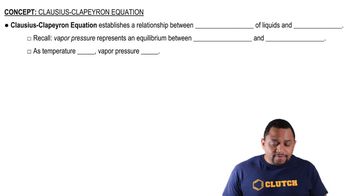(a) When you exercise vigorously, you sweat. How does this help your body cool?
Suppose the vapor pressure of a substance is measured at two different temperatures.
a. By using the Clausius–Clapeyron equation (Equation 11.1), derive the following relationship between the vapor pressures, 𝑃1 and 𝑃2, and the absolute temperatures at which they were measured, 𝑇1 and 𝑇2:
ln𝑃1𝑃2=−Δ𝐻vap𝑅(1𝑇1−1𝑇2)
b. Gasoline is a mixture of hydrocarbons, a component of which is octane (CH3CH2CH2CH2CH2CH2CH2CH3). Octane has a vapor pressure of 13.95 torr at 25°C and a vapor pressure of 144.78 torr at 75°C. Use these data and the equation in part (a) to calculate the heat of vaporization of octane.
c. By using the equation in part (a) and the data given in part (b), calculate the normal boiling point of octane. Compare your answer to the one you obtained from Exercise 11.83.
d. Calculate the vapor pressure of octane at −30°C.
 Verified step by step guidance
Verified step by step guidance
Verified video answer for a similar problem:
Key Concepts
Clausius–Clapeyron Equation

Heat of Vaporization (ΔHvap)

Vapor Pressure

(b) A flask of water is connected to a vacuum pump. A few moments after the pump is turned on, the water begins to boil. After a few minutes, the water begins to freeze. Explain why these processes occur.
The following table gives the vapor pressure of hexafluorobenzene (C6F6) as a function of temperature: (a) By plotting these data in a suitable fashion, determine whether the Clausius–Clapeyron equation (Equation 11.1) is obeyed. If it is obeyed, use your plot to determine ∆Hvap for C6F6.
Naphthalene (C10H8) is the main ingredient in traditional mothballs. Its normal melting point is 81 °C, its normal boiling point is 218 °C, and its triple point is 80 °C at 1000 Pa. Using the data, construct a phase diagram for naphthalene, labeling all the regions of your diagram.
A particular liquid crystalline substance has the phase diagram shown in the figure. By analogy with the phase diagram for a nonliquid crystalline substance, identify the phase present in each area.
In Table 11.3, we saw that the viscosity of a series of hydrocarbons increased with molecular weight, doubling from the six-carbon molecule to the ten-carbon molecule.
(a) The eight-carbon hydrocarbon, octane, has an isomer, isooctane. Would you predict that isooctane would have a larger or smaller viscosity than octane? Why?
